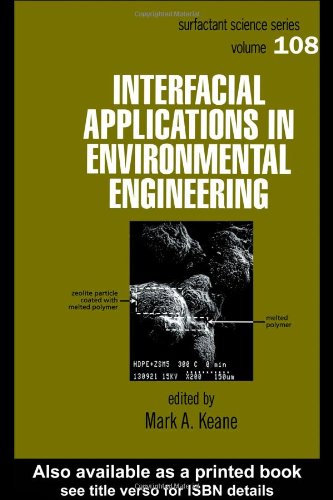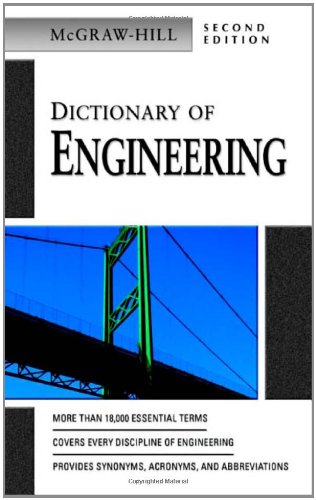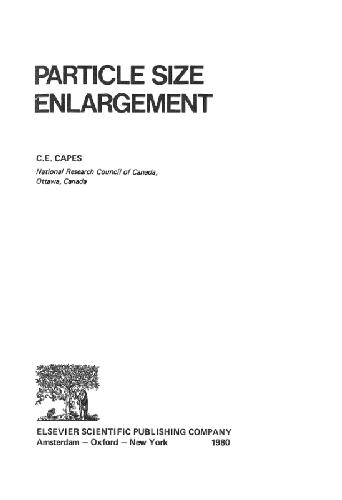Mark A. Keane9780824708665, 0-8247-0866-0
Table of contents :
Interfacial Applications in Environmental Engineering……Page 1
Preface……Page 3
Contributors……Page 8
I. ENVIRONMENTAL POLLUTION……Page 12
II. NOx/SOx ABATEMENT……Page 14
III. WATER TREATMENT: HEAVY METAL AND ORGANIC REMOVAL……Page 16
IV. CATALYTIC APPROACHES TO ORGANIC POLLUTANT REMEDIATION……Page 18
V. WASTE MINIMIZATION: RECYCLE OF WASTE PLASTICS……Page 19
REFERENCES……Page 20
Contents……Page 5
Contents……Page 0
I. INTRODUCTION……Page 23
II. CONTROL OF N2O EMISSIONS……Page 24
A. DeNoxing from Mobile Sources……Page 30
B. DeNOxing from Stationary Sources……Page 32
1. Cu-Containing Zeolite……Page 33
3. Ce-Containing Zeolite……Page 35
A. Mechanistic Studies of NO and N2O Decomposition……Page 36
B. N2O Adsorption on Fe- ZSM- 5……Page 37
1. The Zeolite Framework to TMI Charge Transfer……Page 38
2. The Zeolite Framework as a Charge Reservoir……Page 39
3. Properties of the Zeolite-Containing TMIs and Other Cocations……Page 41
REFERENCES……Page 42
I. INTRODUCTION……Page 47
C. Transient IR Experiments……Page 48
D. Mass Spectrometer Analysis of the Gaseous Products……Page 49
A. Step Transient Response……Page 50
B. Pulse Transient Response……Page 54
C. Proposed Reaction Pathways……Page 56
IV. CONCLUSIONS……Page 58
REFERENCES……Page 59
I. INTRODUCTION……Page 61
A. Preparation of Catalysts……Page 63
B. Characterization Methods……Page 65
A. Characterization of the Catalysts……Page 67
B. NOx Reduction Activity……Page 69
IV. DISCUSSION……Page 72
REFERENCES……Page 74
I. INTRODUCTION……Page 77
II. STATIC INTERACTIONS: EQUILIBRIUM POSITIONS AND ADIABATIC POTENTIAL ENERGY SURFACE……Page 79
A. Gas-Phase Sulfur Oxides……Page 80
B. SO2 on Pt( 111)……Page 82
C. SO2 on Other Transition Metal Surfaces……Page 83
E. SO3 on Transition Metals……Page 85
G. Modified Transition Metals Toward Designed Reactivity……Page 86
IV. CONCLUSIONS……Page 88
REFERENCES……Page 89
I. INTRODUCTION……Page 91
B. FCC Catalyst, Catalyst/ Additive Preparation and Characterization……Page 92
1. Mechanistic Studies of Thiophene Cracking……Page 93
A. Sulfur Distribution and Sul.des in FCC Gasoline……Page 95
1. Cracking of Thiophene over the USY Zeolite……Page 97
2. Cracking of Sul.des in FCC Gasoline over a Catalyst of Gasoline Tracking Desulfurization……Page 101
3. Cracking Mechanisms for Thiophene and Alkyl-Thiophenes……Page 102
1. Design of the Catalyst/ Additive……Page 106
2. Selection of Metal Oxides for the Support……Page 107
D. Evaluation of the Catalyst for Gasoline Cracking Desulfurization……Page 108
1. Influence of the Amount of Additive in the FCC Catalyst on Sulfur Removal……Page 110
2. Influence of the Catalyst/ Oil Ratio on Sulfur Removal……Page 111
4. Influence of the Additive on the Hydrocarbon Composition and the Octane Number of Gasoline……Page 112
IV. CONCLUSIONS……Page 113
REFERENCES……Page 114
I. BACKGROUND: POLLUTION BY HEAVY METALS……Page 115
III. APPLICATION OF ZEOLITE ION EXCHANGERS……Page 116
IV. EXPERIMENTAL CONSIDERATIONS……Page 117
A. Structural Features of Zeolite Y……Page 119
B. Batch Operation……Page 121
C. Continuous Operation……Page 127
REFERENCES……Page 129
II. LAYERED METAL CHALCOGENIDES……Page 132
III. THIOSPINELS……Page 137
REFERENCES AND NOTE……Page 145
I. INTRODUCTION……Page 147
A. Thiocarbonates……Page 148
C. Potentially Multidenta Ligands……Page 149
D. Dosage Formulas……Page 151
III. RESEARCH ADVANCES ON NOVEL LIGANDS FOR HEAVY METAL CHELATION……Page 152
REFERENCES……Page 157
I. SORPTION BEHAVIOR……Page 159
A. Organic Cosolvent Effect……Page 166
B. Effects of Spill Age……Page 172
C. Effects of Soil-Phase and Aqueous-Phase Ionic Strengths……Page 175
III. PHOTODEGRADATION OF OIL RESIDUALS UNDER ADVANCED OXIDATIVE PROCESSES……Page 180
IV. CONCLUSIONS……Page 183
REFERENCES……Page 184
I. BACKGROUND: THE ENVIRONMENTAL DIMENSION……Page 185
II. POLLUTANT ABATEMENT USING CARBON ADSORBENTS……Page 186
A. Catalytic Production of Carbon Nanofibers……Page 188
1. Batch Adsorption Studies……Page 190
A. Characteristic Features of the Carbon Adsorbents……Page 192
B. Phenol Adsorption……Page 200
C. Chlorophenol Adsorption……Page 204
D. Semibatch Phenol Uptake……Page 207
VI. CONCLUSIONS……Page 208
REFERENCES……Page 209
I. INTRODUCTION……Page 213
A. Origin of the Charging-Energy Term……Page 215
B. Significance of Aggregation-Derived Neutral Size Sequestration……Page 217
B. Alternate Methods for Estimating Effective Acidity Constants……Page 219
A. Results from Simulated Data……Page 221
B. pQ Values Derived from Data in the Published Literature……Page 225
IV. CONCLUSIONS……Page 229
REFERENCES……Page 233
I. INTRODUCTION……Page 235
B. Catalyst Characterization……Page 237
D. Temporal Analysis of Products: Catalytic Studies……Page 238
B. Activity of Uranium Oxide Catalysts……Page 239
C. Temporal Analysis of Products: Mechanistic Studies……Page 241
D. Effect of Cofeeding Water……Page 244
IV. CONCLUSIONS……Page 248
REFERENCES……Page 249
I. BACKGROUND……Page 251
II. STRATEGIES FOR HANDLING/ DISPOSING OF CHLORO- ORGANICS……Page 252
A. Environmental Considerations……Page 254
B. Economic Considerations……Page 255
IV. CATALYTIC HYDRODECHLORINATION: REVIEW OF RECENT LITERATURE……Page 256
A. Nature of the Catalysts……Page 257
B. Hydrodechlorination and Catalyst Structure……Page 259
C. Hydrodechlorination Activity……Page 263
D. Hydrodechlorination Selectivity……Page 266
VI. CONCLUSIONS……Page 268
REFERENCES……Page 269
I. INTRODUCTION……Page 275
1. Bandgap Excitation……Page 276
2. Electron/Hole Recombination……Page 277
3. Band Bending and the Schottky Barrier……Page 278
4. Quantum Size Effects (QSE)……Page 279
B. TiO2 Photocatalysis……Page 280
1. Surface Chemistry of TiO2: The Role of Defect Sites……Page 281
2. Nanoparticles: Current Synthetic Methods……Page 282
A. Background……Page 283
1. Mask Preparation……Page 285
2. TiO2 Nanoparticle Array Preparation……Page 288
4. Outlook……Page 289
IV. SUMMARY……Page 291
REFERENCES……Page 292
I. INTRODUCTION……Page 295
A. The Right Form……Page 298
D. The Right Time……Page 299
B. The Aerosol Dispenser……Page 300
C. Nonfoaming Bubble Fractionation……Page 301
IV. THE AEROSOL CATALYST……Page 302
B. The Role of Rhodium……Page 303
C. The Role of Rhenium……Page 304
VI. RESULTS……Page 305
VII. LOOKING AHEAD……Page 310
VIII. BENEFITS……Page 312
ACKNOWLEDGMENTS……Page 313
REFERENCES……Page 314
A. Background……Page 315
B. Feedstock Recycling: Current State of the Art……Page 317
B. Experiments……Page 320
C. Results and Discussion……Page 322
A. Introduction……Page 325
1. Materials and Reaction Preparation……Page 326
2. Product Analysis……Page 327
1. Overall Analysis……Page 329
2. Thermal Cracking in Polymer Degradation……Page 330
3. Catalytic Cracking: Two Operating Conditions……Page 331
4. A Study on Catalyst Regeneration……Page 337
5. A Study on Catalyst Deactivation in Multiple Addition Series……Page 339
IV. CONCLUSION……Page 343
REFERENCES……Page 344
I. PLASTIC WASTES AND ASSOCIATED TREATMENT……Page 349
II. DEHALOGENATION ISSUES IN THE CHEMICAL RECYCLING OF PLASTIC WASTE……Page 350
III. OUR APPROACH TO THE DEHALOGENATION OF PLASTIC- DERIVED OIL……Page 351
A. Catalytic Dechlorination of Chloro-Organic Compounds from PVC- Containing Mixed Plastic- Derived Oil over Iron Oxide Catalysts……Page 352
B. Removal of Organic Chlorine Compounds from Municipal Waste Plastic – Derived Oil by Catalytic Dehydrochlorination over Iron Oxides ( Fe3O4- Carbon), Zinc Oxide, Magnesium Oxide, and Red Mud……Page 357
C. Catalytic Dehalogenation of Brominated Flame- Retardant- Containing High- Impact Polystyrene ( HIPS- Br) Mixed with Polyvinyl Chloride – Derived Oil over Fe3O4- Carbon Composite Catalyst ( TR00301)……Page 366
IV. CONCLUDING REMARKS……Page 370
REFERENCES……Page 371







Reviews
There are no reviews yet.